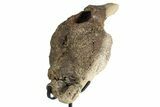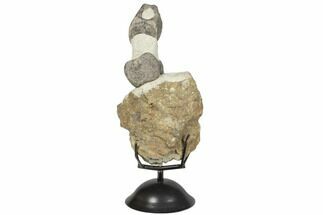This Specimen has been sold.
5.1" Hadrosaur (Edmontosaurus) Caudal Vertebra w/ Pathology - Montana
This is a caudal vertebra of a hadrosaur (Edmontosaurus annectens) from the Hell Creek Formation of Dawson County, Montana. It features a bone deformity (pathology) along the inferior-anterior surface of the centrum. The unique white to brown color preservation of the vertebra indicates that half of the vertebra was exposed to the sun for an extended period of time.
The entire vertebra measures 5.1 x 2.7 x 2.5" and on the included metal display stand, this vertebra stands 7.6" tall.
There is some gap fill restoration through the right pedicle and a repaired crack through the left pedicle.
The entire vertebra measures 5.1 x 2.7 x 2.5" and on the included metal display stand, this vertebra stands 7.6" tall.
There is some gap fill restoration through the right pedicle and a repaired crack through the left pedicle.
About Edmontosaurus
Edmontosaurus is one of the largest Hadrosaurs, and one of the most widespread: fossil remains have been found across western North America, from Colorado to northern Alaska. This large herbivore was about the same size as the contemporary predator Tyrannosaurus, reaching 39 feet in length and an average weight of about 6 tons. Named after Edmonton, the capital of the Canadian province of Alberta where its first fossils were discovered, Edmontosaurus was a gregarious terrestrial herbivore that ground up low-lying plant material with its large battery of ever-restoring teeth. Numerous skin impressions and mummified specimens show us that Edmontosaurus had scaly skin, and its forelimbs were enclosed in a fleshy "mitten" serving a purpose similar to a hoof. Edmontosaurus was a member of the Saurolophine clade of Hadrosaurs, meaning they had little to nonexistent crests on the backs of their skulls.
Edmontosaurus is one of the largest Hadrosaurs, and one of the most widespread: fossil remains have been found across western North America, from Colorado to northern Alaska. This large herbivore was about the same size as the contemporary predator Tyrannosaurus, reaching 39 feet in length and an average weight of about 6 tons. Named after Edmonton, the capital of the Canadian province of Alberta where its first fossils were discovered, Edmontosaurus was a gregarious terrestrial herbivore that ground up low-lying plant material with its large battery of ever-restoring teeth. Numerous skin impressions and mummified specimens show us that Edmontosaurus had scaly skin, and its forelimbs were enclosed in a fleshy "mitten" serving a purpose similar to a hoof. Edmontosaurus was a member of the Saurolophine clade of Hadrosaurs, meaning they had little to nonexistent crests on the backs of their skulls.
Because of its age and sedimentary composition, the Hell Creek Formation has become one of the most paleontologically studied areas in the world. 158 genera of animals and 64 genera of plants are known from the formation and new discoveries are made frequently. In addition to Tyrannosaurs, Ceratopsids, and Hadrosaurs, the formation has yielded remains of amphibians, reptiles, lizards, snakes and turtles, fish and sharks, avian and non-avian dinosaurs, and mammals. The Hell Creek Formation gives the most complete understanding of the environment just before the Cretaceous-Paleogene extinction.
SPECIES
Edmontosaurus annectens
LOCATION
Dawson County, Montana
FORMATION
Hell Creek Formation
SIZE
5.1 x 2.7 x 2.5"
CATEGORY
SUB CATEGORY
ITEM
#244649
We guarantee the authenticity of all of our specimens.
 Reviews
Reviews
















